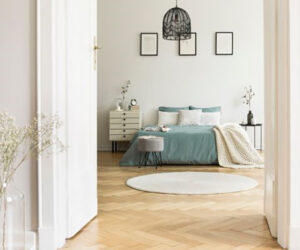If you’re planning to resurface your interiors, engineered wood flooring is the perfect option. This hard-wearing alternative to solid wood flooring isn’t just affordable; it’s also a sustainable choice for those looking for eco-friendly products. But, just because it’s sustainable doesn’t mean you have to sacrifice style or colour options when choosing engineered wood flooring. With Wood Flooring Ireland, you have a full range of colour options, widths and inviting hues to consider.

Keen to what is engineered wood flooring made of? And what are the benefits of engineered wood flooring? Below, we’ll look at the key information you need to know about it, making it easy for you to find quality flooring for your interiors.
Engineered wood flooring is a robust and eco-friendly choice of flooring material. What is engineered wood flooring made of? Unlike traditional flooring, engineered wood flooring is made of several bonded layers of wood, with an upper layer made from premium solid wood. The veneer layer of engineered wood flooring is thick, with most measuring more than 2mm. A more basic engineered wood floor would be a 3-ply construction, but more expensive options would have a 5-ply construction.
These multiple layers make engineered wood flooring exceptionally durable. Unlike conventional solid wood flooring, engineered wood can withstand extreme temperature and copes well when exposed to moisture and humidity. A basic wood flooring might only last 10 years whereas engineered wood flooring could have a lifespan of 30 or more years.
This resilience delivers one of the key advantages of engineered wood flooring, allowing it to be used in spaces like bathrooms and kitchens.
Engineered wood flooring can also be used with under-floor heating systems. If you are installing an under-floor heating system you need to consider the density and thickness of the wood. The denser the wood is, the better it will be at transferring the heat. Similarly, you do not want it too thick as it will trap the heat.
At Wood Flooring Ireland, we recommend going with our 14/2mm thickness options. What this means is that the wood has a 2mm top layer of solid Oak and 14mm in total. This is the ideal measurement for anyone considering an under-floor heating system in their homes.
Engineered flooring is also a cost-effective choice for homeowners looking to keep refurbishment budgets in check. The unseen inner layers tend to be made from plywood, with only the external veneer being made from solid wood. This also makes it an eco-friendly choice if you’re asking yourself, ‘Is engineered wood flooring good for the environment?‘.
Engineered wood flooring is also effortless to install yourself; however, we highly recommend hiring professionals to lay it.
Now we know what engineered wood is and its benefits, we can jump into the different types of wood flooring available:
One of the most popular choices for engineered wood is chevron flooring. This type of flooring is instantly recognisable thanks to the V-shaped motif it produces when panels have been laid out. This style of flooring has been popular for hundreds of years and is perfect if you’re looking to inject character into a space.
Herringbone wood flooring is quite similar to chevron flooring. However, Herringbone flooring tends to be made up of smaller individual planks. When properly aligned, these planks form a distinctive zigzag pattern. Unlike the 45-degree alignment of chevron flooring, herringbone flooring tiles are cut at a 90-degree angle. This results in a slightly more staggered impression that makes it suitable for all room sizes.
Plank wood flooring is another option to consider. Long planks can be used in small and large spaces alike. If you’re working with a smaller room, long planks can give the illusion of space. Wide, long planks can also be used to complement a larger room with a sense of scale.
Colour is crucial when choosing a new floor for any individual room. At Wood Flooring Ireland, you have plenty of beautiful colour options to choose from.
Light coloured flooring is a good option if you’re looking to resurface a guest bedroom or space that is only occasionally used. Although lighter woods are very effective at bouncing around light, they also tend to show up dirt and grime more easily.
Warmer, medium-toned flooring is a good option if you’re planning on reflooring open-plan interiors. Warm tones look great in contemporary and traditional spaces, with richer hues, meaning you won’t have to worry too much about daily cleaning.
If you’re looking to overhaul your interiors with a sense of luxury, go for dark wood flooring. Darker hues are a practical option for rooms that see a lot of foot traffic. They’re ideal for larger spaces but should be used cautiously in smaller rooms.
Taking care of an engineered wood floor is effortless. Compared to solid wood, engineered wood flooring is incredibly durable with improved structural integrity. This means it won’t become damaged when exposed to occasional moisture and extreme temperatures.
You’ll need to carry out some basic maintenance to ensure your floors remain looking their best. If you’re wondering how to clean engineered wood floors, the advice is fairly similar to how you’d care for a standard solid wood floor. Avoid aggressive cleaning products and anything that includes wax or soap when tackling cleaning jobs. Always look for floor cleaning solutions that have been formulated for use on engineered wood flooring.
Eventually, you’ll have to contend with scratches and scuffs, and you can easily do this by sanding your wood flooring. However, you can pre-empt such damage by applying an oiled or lacquered finish to your flooring upon installation.
Eager to overhaul your interiors with engineered wood flooring? Wood Flooring Ireland is here to help.
Browse our selection of Plank, Herringbone and Chevron flooring and get a free sample or if you know your room measurements, order online now!